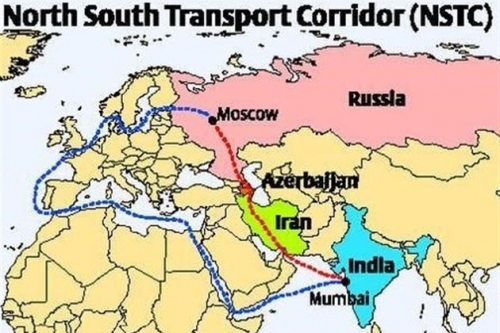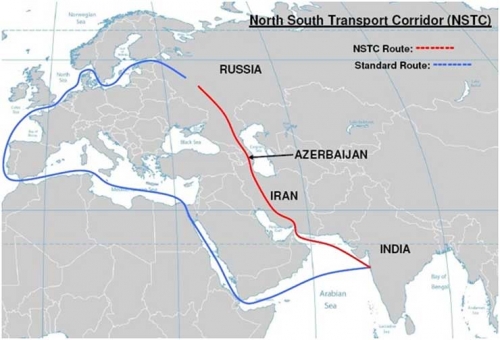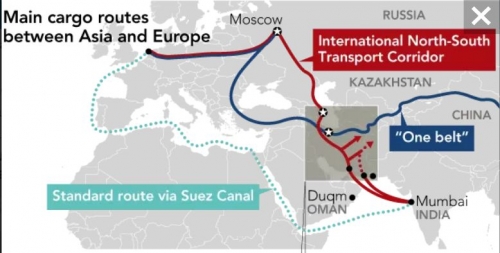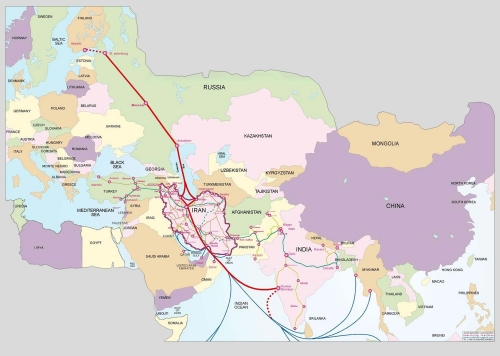samedi, 26 septembre 2020
The International North-South Transport Corridor: Shifting Gears in Eurasian Connectivity

The International North-South Transport Corridor: Shifting Gears in Eurasian Connectivity
As the centre of gravity of the global power play tilts towards its economic underlining,
issues like trade, connectivity and infrastructure have come to warrant greater significance in foreign policies. This holds particularly true in Central Asia where the need for investment coupled with its strategic geographical stretch has drawn increasing attention towards the potential of transport corridors as catalysts of economic integration and connectivity. While China’s colossal Belt and Road Initiative (BRI) has been at the centre of global attention, India, Iran and Russia have mapped out their own plans for a transcontinental transport corridor. The International North-South Transport Corridor (INSTC) is a landmark initiative for Eurasian connectivity. Twice as short as the traditional trade route between India and Russia, the corridor augments economic cooperation and gives sea access to land-locked member states in Central Asia. This paper seeks to advance an understanding of the development of the INSTC and examine its significance in the Asian transportation grid. In doing so, it analyses the geopolitical dynamics that underlie the project’s agenda, examines it in the context of the BRI, explores the stumbling blocks in its developments and comments on its future prospects while highlighting some recommended policy changes.
Bridging the Connectivity Gap
The International North-South Transport Corridor is a 7200 km-long multimodal transportation network that links the Indian Ocean to the Caspian Sea via the Persian Gulf onwards into Russia and Northern Europe. Launched as a joint initiative by India, Iran and Russia in 2000 and ratified by the three in 2002, the corridor has now expanded to include eleven more members, namely, Azerbaijan, Armenia, Kazakhstan, Kyrgyzstan, Tajikistan, Turkey, Ukraine, Syria, Belarus, Oman and Bulgaria (observer status). The 2000 agreement was set in motion with the objectives of simplifying and developing transportation services, enhancing access to global markets and coordinating transit policies while also ameliorating route security. India’s accession to the Shanghai Cooperation Organisation (SCO) in 2017 and the Ashgabat Agreement in 2018 have only increased these connectivity prospects.

Figure 1: The INSTC route and the standard Suez route. Credit: Wikimedia Commons
Although the original agreement envisaged connecting India and Iran to Central Asia and Russia, the potential of the corridor to gradually envelop the Baltic, Nordic and even the Arctic regions is no longer far-fetched. The first or the central branch of the corridor of the INSTC begins from the Mumbai port in the Indian Ocean Region and connects to the Bandar Abbas and Chabahar ports on the Strait of Hormuz and then passing through the Iranian territory via Nowshahr, Amirabad and Bandar-e-Anzali, runs by the Caspian Sea to reach the Olya and Astrakhan Ports in Russia. The second or the western branch connects the railway network of Azerbaijan to that of Iran via the cross-border nodal points of Astara (Azerbaijan) and Astara (Iran) and further to India via sea route. The third or the eastern branch of the corridor connects Russia to India through the Central Asian countries of Kazakhstan, Uzbekistan and Turkmenistan. Notably, the INSTC is multimodal in nature, encompassing sea, road and rail routes in its network to offer the shortest route of connectivity for Eurasian cargo transport. Bereft of the INSTC, cargo between India and Russia moves either through the Netherlands’ port of Rotterdam or China’s Qingdao port which takes over 50 days for transit. The INSTC in its completion cuts this transit time down to about 16-21 days. It also offers a considerably shorter route than the Suez Canal transit passage which, besides being overloaded, is also much more expensive than the former. This was made apparent by the dry run conducted by the Federation of Freight Forwarders’ Association of India (FFFAI) in 2014 with the objective of discerning structural problems and missing links in the corridor. The study demonstrated that the INSTC was 30 percent cheaper and 40 percent shorter than the traditional Suez route, slashing the transit time to an average of 23 days for Europe-bound shipments from the 45-60 days taken by the latter. Although the study identified streamlining and coordination with allied agencies as some of the pitfalls, it ascertained that the corridor did not pose infrastructural or security hurdles in the maiden dry run. The second dry run, reportedly conducted in 2017, generated a similar sense of optimism.[1]

With an estimated capacity of 20-30 million tons of goods per year, the corridor facilitates transit and bolsters trade connectivity. But besides the more obvious benefits of increased trade, the time and cost savings coupled with access to new markets also translate into increased competitiveness in exports. This holds particularly true for the INSTC because unlike the BRI, the INSTC nations have a level-playing field, allowing for benefits to be distributed more evenly. For India, the corridor also augments its ‘Make in India’ initiative. Access to nations of the Eurasian Economic Union alone can offer it a market of 173 million people. Additionally, the corridor facilitates free trade agreements, opens new opportunities to engage with more regional trading blocs and in harmonising policies while bringing about a more uniform legal climate and enhances regional stability.
Geopolitical Geometries
The INSTC acts as a gateway for India to reconnect with the resource-rich nations of Central Asia and Eurasia. It makes for one of the most salient aspects of India’s Connect Central Asia policy which was initiated by Indian policy markers in 2012 in a bid to revamp its ties with Central Asia. In a way, the INSTC serves the more proactive stance that the Indian foreign policy has come to adopt in recent years. For a long time, India’s westward connectivity had been disrupted by its contentious relations with Pakistan. In providing a direct link to the Iranian ports of Chabahar and Bandar Abbas, the INSTC allows the nation to bypass the Pakistan hurdle. Furthermore, it presents India with an opportunity to re-engage with Russia which, in the light of India’s increasingly cordial relations with the United States, has been advancing its relations with Pakistan. In 2018, bilateral trade between India and Russia stood at USD $8.2 billion, a dismal amount compared to the envisaged target of US $30 billion in bilateral trade by 2025. The need to re-energize trade coupled with the lack of a coterminous border renders the INSTC imperative for the two.
The INSTC also makes way for India to offset growing Chinese presence in the region. The partly Indian-built port of Chabahar in Iran is not only central to India’s connectivity to Central Asia but also holds significant strategic importance. Located just 72 kilometres west of the Pakistani port of Gwadar which has been developed under the BRI, Chabahar allows India to counter the Chinese strategic foothold in the Indian Ocean Region. The port is also pivotal for land-locked Afghanistan to unlock its trade potential and reduce its dependence on Islamabad. In this context, it is worthwhile to note that, positioned at the crossroads of the North-South and East-West transit corridors, Iran is the lynchpin to the success of the INSTC. Isolation of Iran in the wake of the U.S. sanctions then can inevitably put the actualisation of the INSTC in jeopardy. However, the signing of an MoU between the state-backed Container Corporation of India (Concor) and Russian Railways Logistics Joint Stock Company (RZD) in 2020 to transport cargo via the INSTC despite the threat of U.S. sanctions indicates a promising outlook for the full operationalisation of the corridor.
The geopolitical geometries of the INSTC are complicated not only by tangled relations with extra-regional players but also amongst the members themselves. Azerbaijan’s accession to the INSTC in 2005 spurred the corridor’s spread in the Caucasus and heralded the bridging of missing links like the Qazvin-Rasht-Astara railway line. Anticipating up to seven million tons of cargo transit through its territory in the medium term, Azerbaijan has agreed to finance $500 million for the project. But besides the economic benefits, the corridor also makes for a geopolitical asset for Azerbaijan in offering an opportunity to further isolate Armenia with which the country shares adversarial relations. The INSTC undermines Armenia’s own underfunded regional railroad initiative by providing more suitable economic dividends and linking Iran with Turkey via Georgia’s Black Sea Ports while bypassing those of Armenia with the Baku-Tbilisi-Kars route. Notably, for Armenia, the completion of the Armenia-Iran Railway Concession Project would bring colossal direct benefits for its economy by allowing it to avoid the Turkey and Azerbaijan blockade. However, given the paucity of funds, the Armenian project has remained only on paper. Another case in point is the possibility of friction in Russia-Iran relations in the future if a sanctions-free Iran makes headway in becoming an energy hub and gaining larger shares in the oil and gas markets of Europe which has been striving to reduce its dependence on Russian gas. Moreover, realities of the INSTC’s geopolitical geometries may complicate even further if the corridor expands to include countries from the Baltic and Nordic regions along with other interested states like Japan under its ambit. Nevertheless, given that the main argumentation behind the corridor is to reap commercial benefits, it is unlikely for the geopolitical rationale to override economic reasoning.
The INSTC and BRI: A Harmonious Grid?
The INSTC and China’s BRI are both colossal multi-modal undertakings which enhance economic connectivity and promote infrastructural growth. However, conceived almost a decade before the launch of the BRI, the INSTC is a much older project. Unlike the BRI where China plays the role of the foreman, it follows a much more multilateral approach with multiple stakeholders participating on a level playing field. INSTC proposals are also devoid of ‘debt-trap’ fears which have often plagued the appeal of the BRI. While this makes the INSTC much more transparent and reliable and thereby increases its tenability in the long run, it also implies more constraints in its development process. The shortage of funds for constructing missing links in the corridor is one such example. As the helmsman of the BRI, China is not only willing to invest large sums into the project but is also willing to risk markedly low returns on its long-term investments. This, however, points to the concern that the entire project is a decisive strategic manoeuvre. For India, this holds particularly true for the CPEC stretch on the BRI whose Gwadar port is seen as a catalyst for China to gain a strategic foothold in the Indian Ocean Region. China’s bid to extend ties into Afghanistan and Iran have stirred these tensions further. Nonetheless, it is important to note that Iran’s growing ties with China need not necessarily come at the cost of India-Iran relations. Besides, the North-South axis of the INSTC can, in fact, complement the East-West axis of the BRI to make for a more cohesive transport grid in Eurasia. Although the INSTC and China’s BRI initiative are often pitted against each other, it must be understood that the two are not entirely incompatible with each other.

Bottlenecks and Constraints
Progress on the INSTC has taken place in fits and starts. Following the progress made in the first few years of its inception, development on the corridor slowed down from 2005 to 2012. Progress picked up the pace again after the sixth meeting of the INSTC members in 2012 and the project has been gradually gaining momentum since. Coincidently, this was the same year in which India launched its ‘Connect Central Asia’ initiative. One reason behind the sluggish pace of progress was the imposition of sanctions on Iran which isolated it on the global stage. The other major stumbling block has been the lack of financial backing. None of the three main participants has pockets deep enough to ensure unwavering funds for a project of this scale. Different stakeholders are funding different sub-projects creating structural and technical problems for the corridor owing to its disjointed nature. One such problem is the break of gauge issue. The standard railway gauge used by Iran, a central transit hub, is different from the broad gauge used by Russia and the Central Asian nations. For instance, the Rasht-Astara rail link requires a change of gauge from the standard one as the line crosses from Iran into Azerbaijan. This necessitates the need for more change of gauge facilities. The presence of multiple stakeholders creates other problems like customs control and documentation issues, lack of harmony in transportation laws and improper insurance coverage.[2] Moreover, the project still lacks an information exchange platform. This points to the absence of adequate digitalisation and private sector participation in the INSTC. Although the corridor has garnered interest from some companies like Deutsche Bahn, private sector involvement in the corridor has largely remained dormant owing to their concerns for steady returns on investment and security fears. The corridor passes through regions with critical security risks — be it instability in the conflict-ridden Caucasus, extremism in Afghanistan, domestic discord or forms of transnational organised crime like drug trafficking. This puts the security of cargo transit into question and few companies are willing to gamble with this risk, putting the project’s economic viability in jeopardy.
The Path to the Future
While the North-South Corridor holds immense potential, its full realisation is contingent on the resolution of the bottlenecks and constraints impeding its progress. Addressing these challenges requires closer cooperation with government agencies and private enterprises at both regional and international levels. First, it is imperative to understand that the main selling point of the corridor is commercial gain from increased connectivity. To this end, the INSTC members must avail and make practical and effective use of its complementarity with the existing grid of transnational corridors in Eurasia owing to the North-South axis that the corridor operates on. Synergy with other corridors will allow the INSTC to create additional positive economic spill-overs. Synchronisation with corridors of the Trans-European Transport Network such as the North-Sea Baltic corridor, with organisations like the Black Sea Economic Cooperation (BSEC) and other nations like Japan, Myanmar and Thailand can significantly enhance the outreach of the project. Second, the INSTC members must incorporate new digital technologies, launch a web portal for information exchange and build digital nodes along the corridor to turn it into a fully integrated networking system. One way of achieving this is to have India, with its robust IT sector, take the lead in the digitalisation of the corridor. The other is to push for greater participation from the private sector which is significantly more efficient in advanced technologies.[3] Third, infrastructural and technical issues must be resolved. Integration of logistics assets, provision of visa facilities, ease of gradients, aggregation of cargo bound in the return direction and increasing availability of change of gauge facilities are some steps in this direction. Fourth, it is equally important to work towards greater harmonisation of policies. This necessitates the creation of high-level working groups and adept integration of policies and laws. It is, however, important to ensure that changes introduced in the direction of legal harmonisation must not be integrated with local laws unexpectedly in a trice but rather in a step-by-step manner to ascertain a smooth transition. Only once these steps are undertaken and the existing bottlenecks removed, can the INSTC members expand the ambit of the project to include new domains like smart energy, blockchain technology, pipeline connectivity, and consider the prospects of extending the corridor to areas like North Africa and the Arctic region.

Conclusion
The International North-South Transport Corridor was initiated based on the vision of India, Russia and Iran to enhance strategic partnership and economic cooperation by augmenting connectivity through Central Asia. Although the initial progress was slow, the project has expanded dramatically to potentially increase its reach up to Northern Europe. Extending its geographical stretch to such an extent and tapping into its vast potential, however, is bound to be a time taking process. Questions over sanctions on Iran and Russia, the mustering of adequate economic wherewithal and lack of private participation still linger. Nonetheless, it would be unwise to judge the corridor’s capacity to deliver before it becomes fully operationalised. Given that development on the corridor is still underway, it can be easily modified to overcome structural problems. Cargo exchange and private participation are also bound to drum up further as Asia slowly develops into a larger consumer market itself. While this presents a positive outlook for the corridor’s future, its actualisation rests on the ability of the member states to maintain sustained efforts.
[1] Hriday Ch. Sharma, “Turning the International North-South Corridor into a ‘Digital Corridor’”, Comparative Politics Russia, 4 (2018), 125, 10.24411/2221-3279-2018-10008.
[2] “INSTC Conference-India 2015”, 87-94.
[3] Hriday Sharma, “Turning the International North-South Corridor into a ‘Digital Corridor’”, 124-138
00:52 Publié dans Actualité, Affaires européennes, Eurasisme, Géopolitique | Lien permanent | Commentaires (0) | Tags : eurasisme, eurasie, europe, asie, affaires européennes, affaires asiatiques, inde, russie, iran, géopolitique, politique internationale |  |
|  del.icio.us |
del.icio.us |  |
|  Digg |
Digg | ![]() Facebook
Facebook



Les commentaires sont fermés.